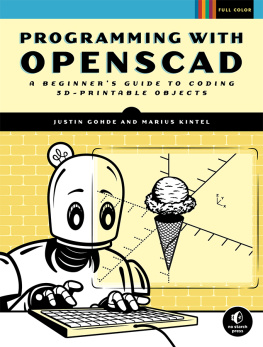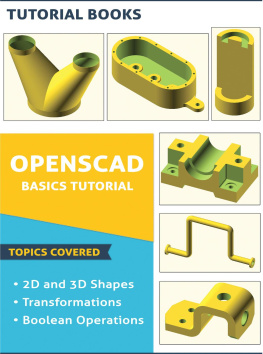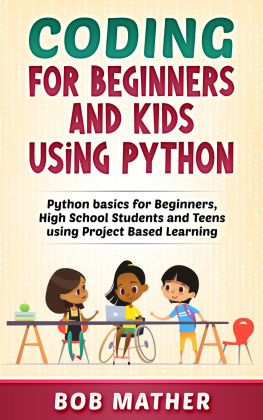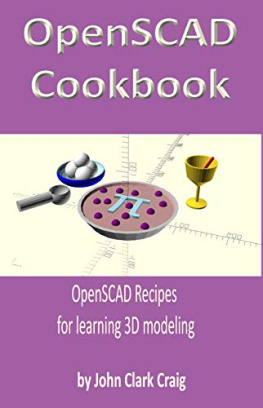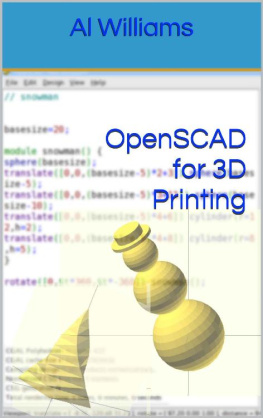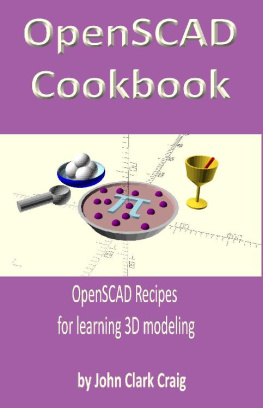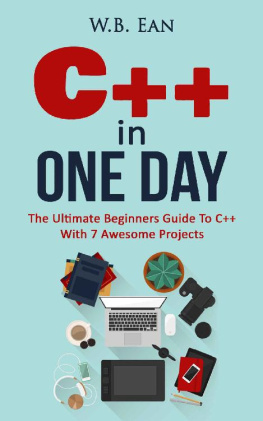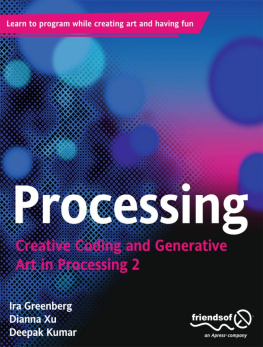
Programming with OpenSCAD
A Beginners Guide to Coding 3D-Printable Objects
by Justin Gohde and Marius Kintel

Programming with OpenSCAD. Copyright 2021 by Justin Gohde and Marius Kintel.
All rights reserved. No part of this work may be reproduced or transmitted in any form or by any means, electronic or mechanical, including photocopying, recording, or by any information storage or retrieval system, without the prior written permission of the copyright owner and the publisher.
ISBN-13: 978-1-59327-954-7 (print)
ISBN-13: 978-1-59327-955-4 (ebook)
Publisher: William Pollock
Production Manager: Rachel Monaghan
Production Editor: Dapinder Dosanjh
Developmental Editor: Jill Franklin
Cover Illustrator: Gina Redman
Interior Design: Octopod Studios
Technical Reviewer: Miro Hronok
Copyeditor: Sharon Wilkey
Compositor: Maureen Forys, Happenstance Type-O-Rama
Proofreader: Emelie Battaglia
Indexer: Beth Nauman-Montana
The following images are reproduced with permission: Figure 1 in the introduction was created by Gustavb and is licensed under the Creative Commons Attribution-Share Alike 3.0 Unported license. The photo of the Leaning Tower of Pisa featured in Figures 7-1 to 7-4 is by Svetlana Tikhonova. The image is covered by the CC0 1.0 Universal (CC0 1.0) Public Domain Dedication license.
For information on book distributors or translations, please contact No Starch Press, Inc. directly:
No Starch Press, Inc.
245 8th Street, San Francisco, CA 94103
phone: 1.415.863.9900; info@nostarch.com
www.nostarch.com
Library of Congress Cataloging-in-Publication Data
LCCN: 2020943329
No Starch Press and the No Starch Press logo are registered trademarks of No Starch Press, Inc. Other product and company names mentioned herein may be the trademarks of their respective owners. Rather than use a trademark symbol with every occurrence of a trademarked name, we are using the names only in an editorial fashion and to the benefit of the trademark owner, with no intention of infringement of the trademark.
The information in this book is distributed on an As Is basis, without warranty. While every precaution has been taken in the preparation of this work, neither the author nor No Starch Press, Inc. shall have any liability to any person or entity with respect to any loss or damage caused or alleged to be caused directly or indirectly by the information contained in it.
About the Authors
Justin Gohde has been teaching math and computer science for more than 20 years. He is the head of computer science at Trinity School in Manhattan, New York, where he oversees the computer science curriculum and programs, including the Design Lab makerspace, which features a wide collection of rapid prototyping tools for supporting computer science, robotics, and other STEAM-focused projects.
Marius Kintel is the primary author and maintainer of OpenSCAD. He is a software engineer with more than 20 years of professional experience in diverse fields such as 3D visualization, physical computing, manufacturing automation, and cloud computing. In 2007, he became involved in the RepRap project out of an interest in learning electronics and the opportunity to transfer his knowledge of 3D graphics into the creation of tangible objects. Together with the rest of the local RepRap team at the Metalab hackerspace in Vienna, Austria, he created OpenSCAD out of a need for an open source multiplatform design tool more suitable for 3D printing. The project was adopted by the maker community at large and has since grown to become one of the most popular open source 3D modeling tools for 3D printing.
About the Technical Reviewer
Miro Hronok is a software engineer mostly working on integrating the Python ecosystem into Fedora Linux. Besides that, he also takes care of the 3D printing stack (including OpenSCAD) in Fedora. He teaches Python and 3D printing basics at the Faculty of Information Technology, Czech Technical University in Prague.
Acknowledgments
First, the authors would like to acknowledge the hard work and significant efforts put in by so many folks operating behind the scenes to make this book happen. As technical reviewer, Miro Hronok made many, many insightful and meaningful contributions to the evolution of each chapter. His feedback and advice were well seen, well considered, and well appreciated. Wed also like to thank everyone at No Starch for their remarkable patience, dedication, and guidance throughout the book writing process. In particular, wed like to acknowledge and thank Bill Pollock for agreeing to publish one of the first books about OpenSCAD, Tyler Ortman for getting the ball rolling, and finally Jill Franklin and Dapinder Dosanjh for getting the project back on track and over the finish line.
Justin would like to thank the many Trinity students and faculty who helped prototype the core lessons and activities presented in this bookin particular, colleagues Noah Segal, Mark Schober, Rob Newton, Jean Kim, and Andrew Rose for their thoughtful contributions to the conversation. Much gratitude is owed to Chris Martin, for initiating scores of London chats on the pedagogical importance of using starting points to motivate self-reflective, inquiry-based learning. And, finally, an infinite debt of thanks is due to Yasuho Mori due to her eternal patience, persistent optimism, and steadfast support.
Marius would like to thank all contributors and users of OpenSCAD. In particular he would like to thank Torsten Paul, who has been instrumental in keeping OpenSCAD moving forward over a number of years. Also, thanks to the Metalab hackerspace in Vienna, and all the diverse and colorful individuals that frequent the space, for creating an inspiring environment where projects like OpenSCAD can evolve. Special thanks go to Claire Wolf for single-handedly cranking out the initial codebase for OpenSCAD and Philipp Tiefenbacher for being an amazing project partner and visionary who helped bootstrap all the activities that eventually became OpenSCAD. And finally, to Jane Tingley for her continuous support, encouragement, and unwavering belief.
Introduction
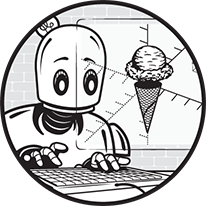
Programming with OpenSCAD: A Beginners Guide to Coding 3D-Printable Objects introduces the versatile, text-based OpenSCAD 3D CAD software. This book guides readers through using arithmetic, variables, loops, modules, and decisions to design a series of increasingly complex 3D designs, all of which are suitable for 3D printing.
What Is OpenSCAD?
OpenSCAD (pronounced Open-S-CAD) is text-based software for creating solid 3D models. It allows you to design these models by writing code, which gives you (the designer) full control over the modeling process and allows for easy changes to any part of your design throughout that process. OpenSCAD also makes it easy to create designs that are defined by configurable parameters, which means you can build designs with change in mind.
OpenSCAD is a descriptive programming language: its coding statements describe the shape, size, and combination of each component of your overall design. OpenSCAD provides two main 3D modeling techniques: you can create complex objects from combinations of simpler shapes (known as
Next page
